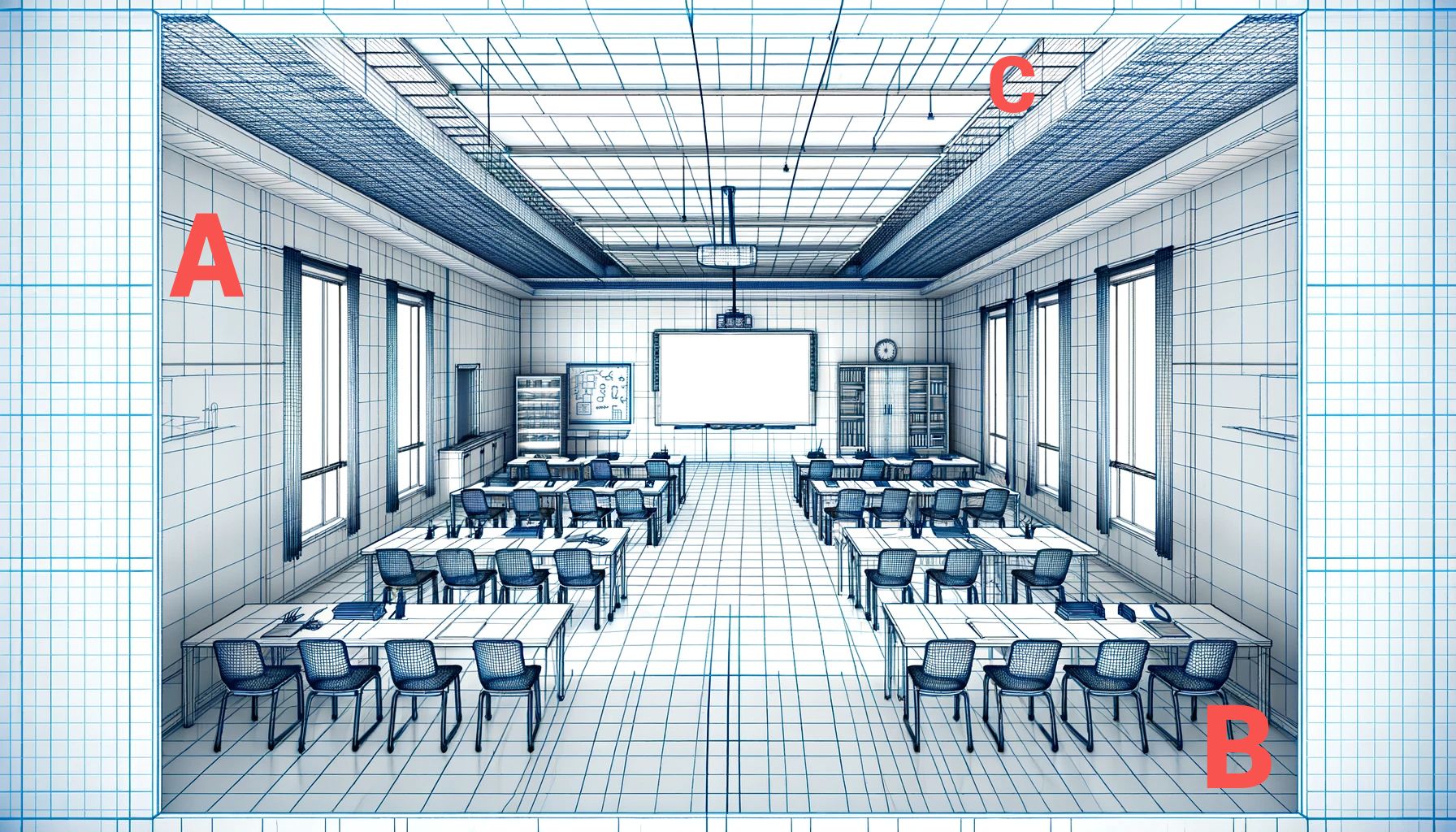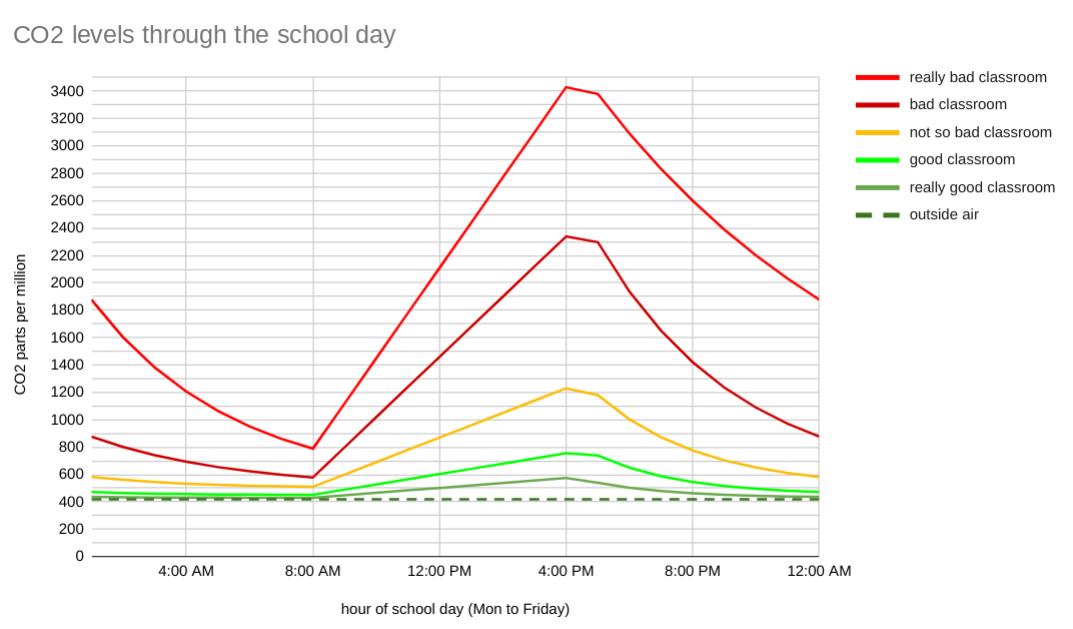Schools Ventilation Progress
To improve school ventilation, there are a number of articles available:
- Healthy indoor air is our fundamental need: the time to act is now - 2022, Professors Lidia Morawska, Guy B Marks, and Jason Monty
- Designing infectious disease resilience into school buildings through improvements to ventilation and air cleaning - 2021, by THE LANCET COVID-19 COMMISSION
- John Snow Project on the CDC’s standards for air in schools - JohnSnowProject.com is a group effort
- Clean Air Crew on school ventilation - CleanAirCrew.org is a group effort
We know we can’t eliminate transmission in schools - we’re just aiming for a “lower chance of spread” with a reproduction number “RO” under 1.0 per infected student or teacher. Google search for RO to better understand that.
School ventilation ideals
The Center for Green Schools (CfGS) has several resources, including an hour-long video on “Unanswered Questions on ASHRAE standard 241 and CDC Ventilation Standard Guidance for Schools”:
Twenty-nine minutes in, there’s a discussion on air filtration instead of fresh air ventilation for cash-strapped schools. The ASHRAE 241 standard understands the economic constraints of the larger school air quality goals.
ASHRAE 241 refers to a standard published by the American Society of Heating, Refrigerating and Air-Conditioning Engineers (ASHRAE). Specifically, ASHRAE 241-2019 is titled “Standard for Ventilation and Acceptable Indoor Air Quality in Residential Buildings.” ASHRAE 241-2019 supersedes the previous version, ASHRAE Standard 62.2-2016.
CfGS’s 25-page toolkit is excellent. Their home page.
A stylized classroom
 |
|---|
| Blueprint depiction of classroom, with false ceiling tiles removed, and A, B & C denoting placement of equipment. |
What we need to do per classroom
In 2024, better classrooms are already sealed against outside heat, cold, and pollution. Depending on the latitude, some air conditioning, too.
- Increased fresh air ventilation (heat recovering*) out through walls (A) or ducted at the ceiling level (existing or new).
- Freestanding (B) air cleaning equipment. Equipment can be DIY (see below) or commercial.
- Or above the ceiling tiles (C).
- Or through the ceiling to roof mounted (C) if there is a flat roof above.
- Monitoring of carbon dioxide (CO₂), which is a “proxy risk” indicator of air that could be carrying viruses from infected people to uninfected people (Pick a study from Google search results). The level of CO₂ would drive the settings of the ventilation and filtering systems. Only gadgets that use NDIR sensors should be used. Wall mounted or above ceiling tiles, too.
- We also need legislation that requires the completion of such work in classrooms. The legislation should also certify that the work has been done, inspections to ensure the work is correct, and measures to intervene if the work is not correct.
- Make it safe in schools for those wanting to wear masks (kids or teachers). We’re not going to recommend masks for everyone in a school setting - this site is about pushing for long-term ventilation, air filtration/cleaning, and CO₂ monitoring to drive those.
Note: Ionization of the air is not recommended as it creates ozone, which is harmful to people. Upper room ultraviolet technology may play a part in virus inactivation as the technology reaches mass production.
We should not wait for #4 before getting started on #1, #2, and #3.
Ideally, #1 & #2 are engineered solutions, fitted by experts and licensed building contractors. You don’t have to wait - freestanding works to fill a gap, and the DIY options (see below) are cheap and effective. They are affordable enough to be donated by parent groups. See the 5th Graders Make… video below.
CO₂ as proxy risk indicator
CO₂ builds up as occupants of a room breathe in and out. When occupants leave a room for the final time in a day, CO₂ naturally decays towards the outside air concentration (420 parts per million if you’re in the countryside). This decay is just slow exchange with lower CO₂ ppm air through tiny gaps in walls, windows, and a big gap under the door.

If the windows are open, CO₂ will not build up so fast, but there has to be an air current to force air through the room. Over a hundred years ago, Florence Nightingale campaigned for decades for windows to be opened to reduce airborne disease transmission in public buildings. She also campaigned for high ceilings in those buildings. Because of the open windows, buildings had to have dialed-up heating systems that would be very expensive today, so we prefer mechanical heat recovery ventilation (MHRV) and energy recovery ventilation (ERV) systems. We can now also scrub the air of viruses (suspended in one-micron size water vapor aerosols) using air filters and cleaners. There are DIY alternatives that are just as good. Air filters do not address the CO₂ levels themselves, which can contribute to drowsiness at very high levels. Air filters do address smoke particles from nearby cars and truck exhausts and pollen, though: PM 2.5.`
